INDIAN ARMED FORCES CHIEFS ON OUR RELENTLESS AND FOCUSED PUBLISHING EFFORTS

SP Guide Publications puts forth a well compiled articulation of issues, pursuits and accomplishments of the Indian Army, over the years

"Over the past 60 years, the growth of SP Guide Publications has mirrored the rising stature of Indian Navy. Its well-researched and informative magazines on Defence and Aerospace sector have served to shape an educated opinion of our military personnel, policy makers and the public alike. I wish SP's Publication team continued success, fair winds and following seas in all future endeavour!"

Since, its inception in 1964, SP Guide Publications has consistently demonstrated commitment to high-quality journalism in the aerospace and defence sectors, earning a well-deserved reputation as Asia's largest media house in this domain. I wish SP Guide Publications continued success in its pursuit of excellence.
- Indian Air Force Aims for Full Indigenous Inventory by 2047 — Air Chief Marshal A.P. Singh
- Rajnath Singh assumes charge as Defence Minister for the second consecutive term
- Interim Defence Budget 2024-25 — An Analysis
- Union Defence budget 2024
- Prime Minister Modi Flies in the LCA Tejas
- New Chapter in India-Italy Defence Ties
- Airpower beyond Boundaries
Exercise Bharat Shakti 2024
Fortifying India's Military Might with Cutting-Edge Technology
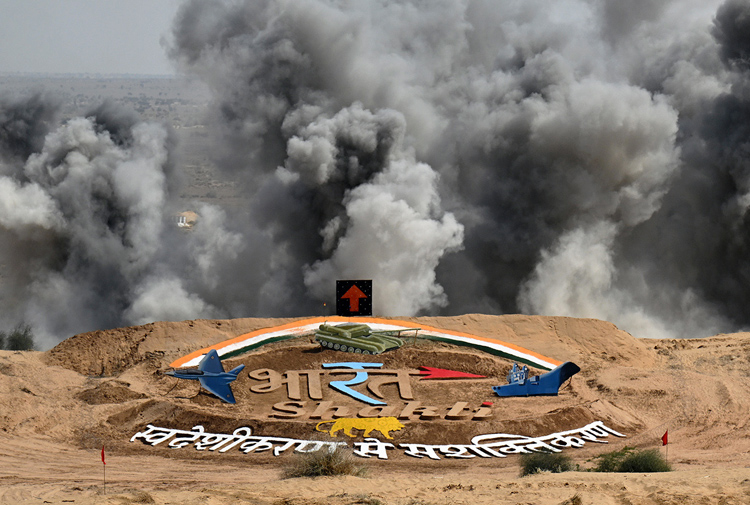
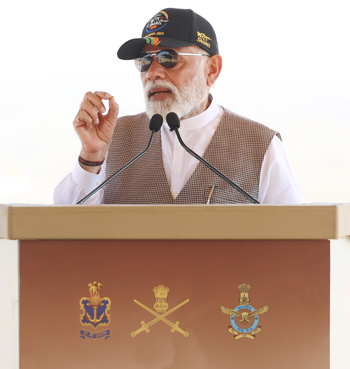
In a rapidly evolving global landscape marked by geopolitical tensions and emerging security threats, nations around the world are continuously enhancing their military capabilities to ensure sovereignty and national security. India, with its vast territorial expanse and diverse geopolitical challenges, has been steadfast in bolstering its defence prowess. The Bharat Shakti Exercise stands as a testament to India's commitment to modernising its armed forces and leveraging advanced technology to safeguard its borders and interests.
Prime Minister Narendra Modi witnessed the tri-service exercise 'Bharat Shakti' at the Pokhran field firing range in Jaisalmer, Rajasthan on March 12, 2024. The exercise was also witnessed by the delegates from more than 30 nations. In his statement, Prime Minister Modi recalled Pokhran's historical significance as the site of India's past nuclear tests andasserted, "This is Pokhran, where India showcased its nuclear capabilities, and today we witness the strength of 'Swadeshikaran se Sashaktikaran' (empowerment through indigenisation)."
The Bharat Shakti Exercise stands as a testament to India's commitment to modernising its armed forces and leveraging advanced technology to safeguard its borders and interests.
Defence Minister Rajnath Singh, Chief of Defence Staff General Anil Chauhan, Navy Chief Admiral R. Hari Kumar, and IAF Chief Air Chief Marshal V.R. Chaudhari witnessed the tri-services firepower which marked it as India's major military exercise of magnitude.
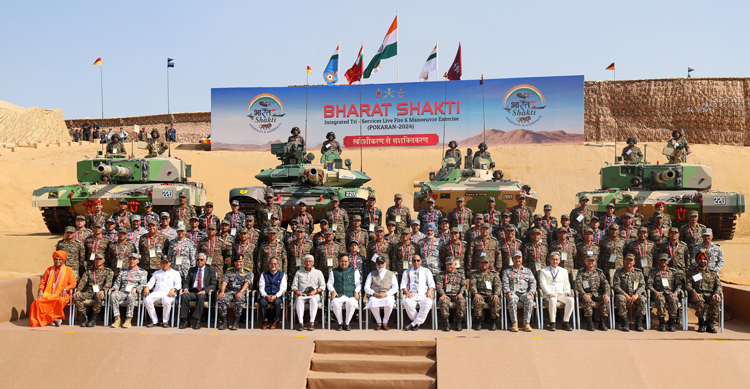
The Bharat Shakti exercise involved showcasing of calibrated tactical employment of niche technology in a tri-services environment against perceived threats.
The Essence of Bharat Shakti Exercise
Bharat Shakti Exercise, an ambitious initiative of the Indian Armed Forces, encompasses a series of large-scale military drills, simulations, and technology showcases aimed at honing combat readiness, fostering interoperability among different branches of the military, and validating the effectiveness of cutting-edge defence technologies. The exercise serves as a platform for synergising the efforts of the Army, Navy, Air Force, and other defence organisations towards achieving strategic objectives.
While showing the military prowess, the thrust remained on showing the indigenous capabilities. Prime Minister Modi highlighted his quest for indigenous tech for the Indian Armed Forces. In Pokhran, he said that in the past decade, the country's defence production has more than doubled, exceeding ₹1 lakh crore. "Over the last 10 years, more than 150 defence startups have emerged, and the armed forces have committed orders worth ₹1,800 crore to support them," Prime Minister said. Modi also emphasised that a self-reliant India in the defence sector instils confidence in the armed forces.
The Bharat Shakti exercise involved showcasing calibrated tactical employment of niche technology in a tri-services environment against perceived threats.
Bharat Shakti Exercise is designed to enhance combat readiness through simulate various combat scenarios, ranging from conventional warfare to counter-insurgency operations, thereby ensuring that the armed forces are well-prepared to tackle any potential threat with precision and agility.
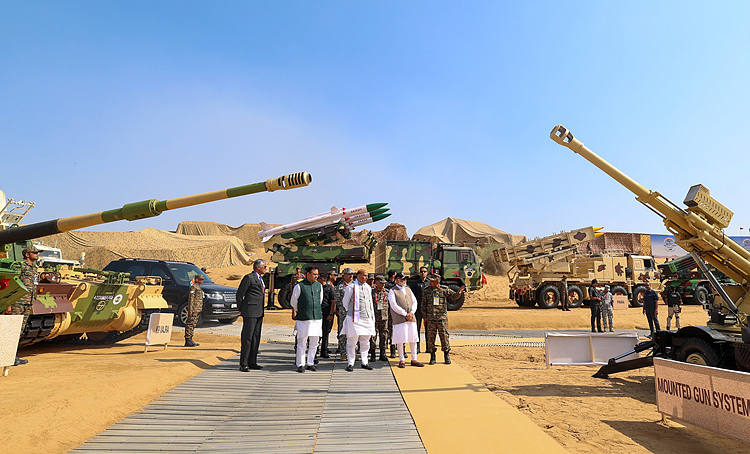
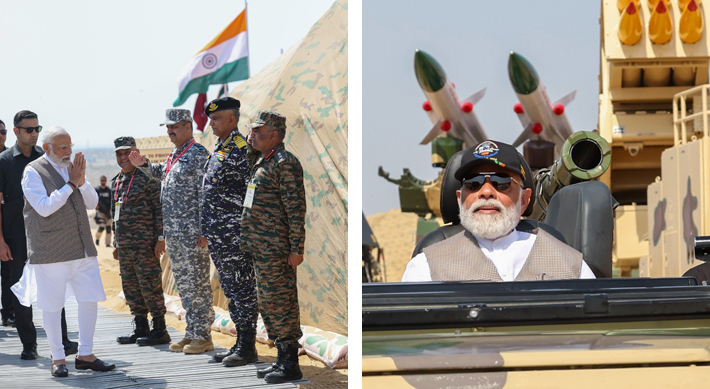
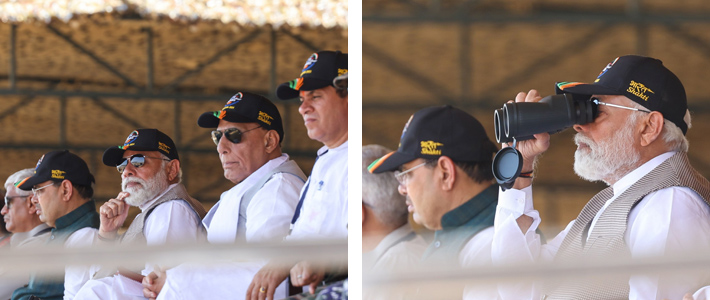
The Exercise displayed indigenous weapon systems including T-90 (IM) Tanks, Dhanush and Sarang Gun Systems, Akash Weapons Systems, Logistics Drones, Robotic Mules, ALH, and various unmanned aerial vehicles. Adding to the firepower, the tri-services also showcased the mobile anti-drone system, BMP-II and its variants.
Bharat Shakti Exercise is designed to enhance combat readiness through simulating various combat scenarios, ranging from conventional warfare to counter-insurgency operations, thereby ensuring that the armed forces are well-prepared to tackle any potential threat with precision and agility.
Indian Air Force demonstrated their aerospace prowess, displayingair superiority and versatility of indigenous aircraft like Light Combat Aircraft Tejas, Light Utility Helicopters, and Advanced Light Helicopters among other aerial platforms.
From the naval side, it displayed Naval Anti-Ship Missiles, Autonomous Cargo Carrying Aerial Vehicles, and Expendable Aerial Targets.
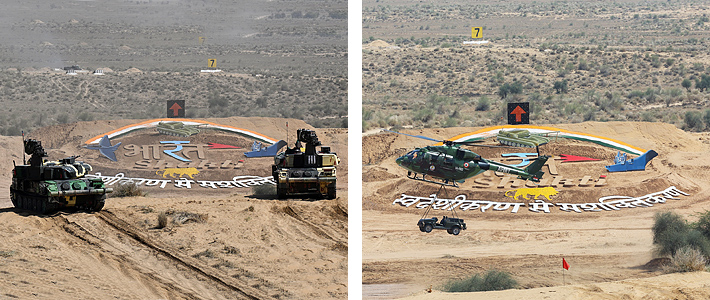
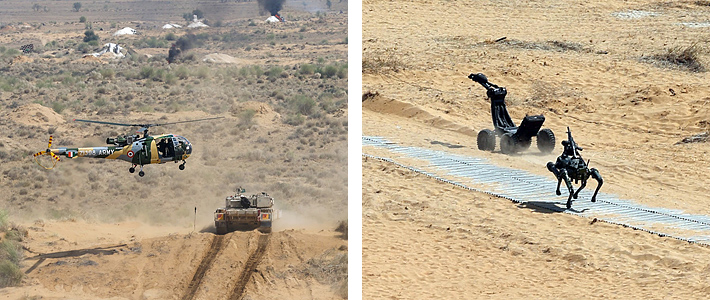


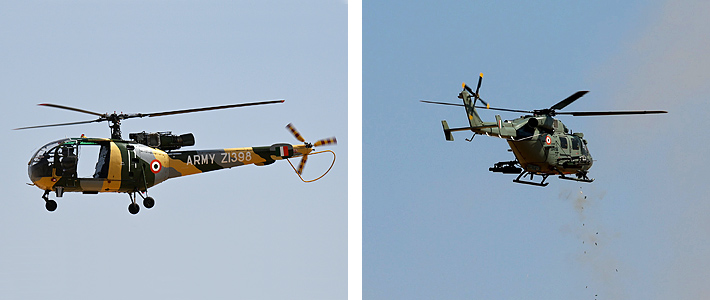

Bharat Shakti: Key Highlights
- Promoting Interoperability: In modern warfare, seamless coordination, and interoperability among different branches of the military are paramount. Bharat Shakti provided an opportunity for joint training exercises, enabling personnel from the Army, Navy, and Air Force to collaborate effectively in diverse operational environments.
- Showcasing Indigenous Technological Advancements: A significant emphasis of the exercise was on showcasing the indigenous defence technologies developed by Indian defence research organisations and industries. "This not only highlights India's self-reliance in defence production but also fosters innovation and encourages the domestic defence industry to strive for excellence," said a senior army officer who led the key planning for the exercise.
Indian Army Technology: Driving Force Behind Bharat Shakti
The Indian Armyplayed a pivotal role in the Bharat Shakti, demonstrating the efficacy of the Integrated Battlefield Management System (IBMS). The IBMS is a state-of-the-art command and control system that integrates various battlefield assets, including sensors, communication networks, and decision support tools, to provide real-time situational awareness to commanders. It enables faster decision-making and enhances the overall operational efficiency of the Indian Army.
Bharat Shakti also demonstrated emerging technologies --Artificial Intelligence (AI) and Machine Learning (ML) in analysing the data in the exercise. AI and ML algorithms were increasingly utilised to analyse vast amounts of data collected from sensors, drones, and surveillance systems, thereby facilitating predictive analytics, threat detection, and autonomous decision-making on the battlefield.
Bharat Shakti provided an opportunity for joint training exercises, enabling personnel from the Army, Navy, and Air Force to collaborate effectively in diverse operational environments.
UAVs and drones have emerged as invaluable assets for reconnaissance, surveillance, and target acquisition purposes. They provide real-time aerial reconnaissance capabilities, enabling the Indian Army to gather vital intelligence and monitor remote areas effectively. During the exercise, the armed forces in conjunction, demonstrated a fleet of swarm drones that showcased remarkable precision striking capabilities throughout the exercise.
India has made significant progress in developing indigenous weapon systems, including tanks, artillery, missiles, and small arms. Projects like the Arjun Main Battle Tank, Pinaka Multi-Barrel Rocket Launcher System, and BrahMos supersonic cruise missile showcase India's capability to design, develop, and produce cutting-edge military hardware.
The Bharat Shakti Exercise aimed to leverage advanced technologies, fostering interoperability among different branches of the military, and promoting indigenous defence production. The thrust on indigenisation has resulted in the development of fighter jets, aircraft carriers, and a series of combat helicopters. Most notably, India has geared to build the next-generation jet engine and manufacture 5th-generation fighter jets domestically.
The author is a defence editor and security expert. He writes on National Security, Military Technology, Strategic Affairs & Policies.





